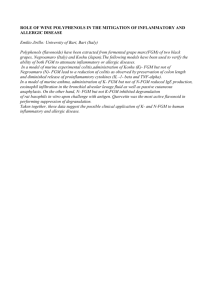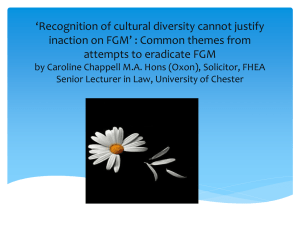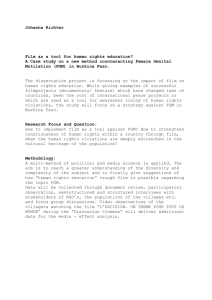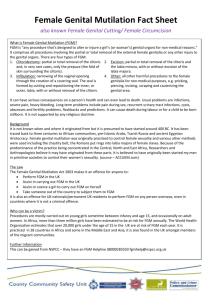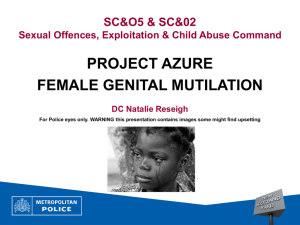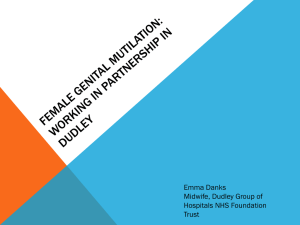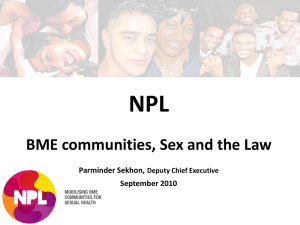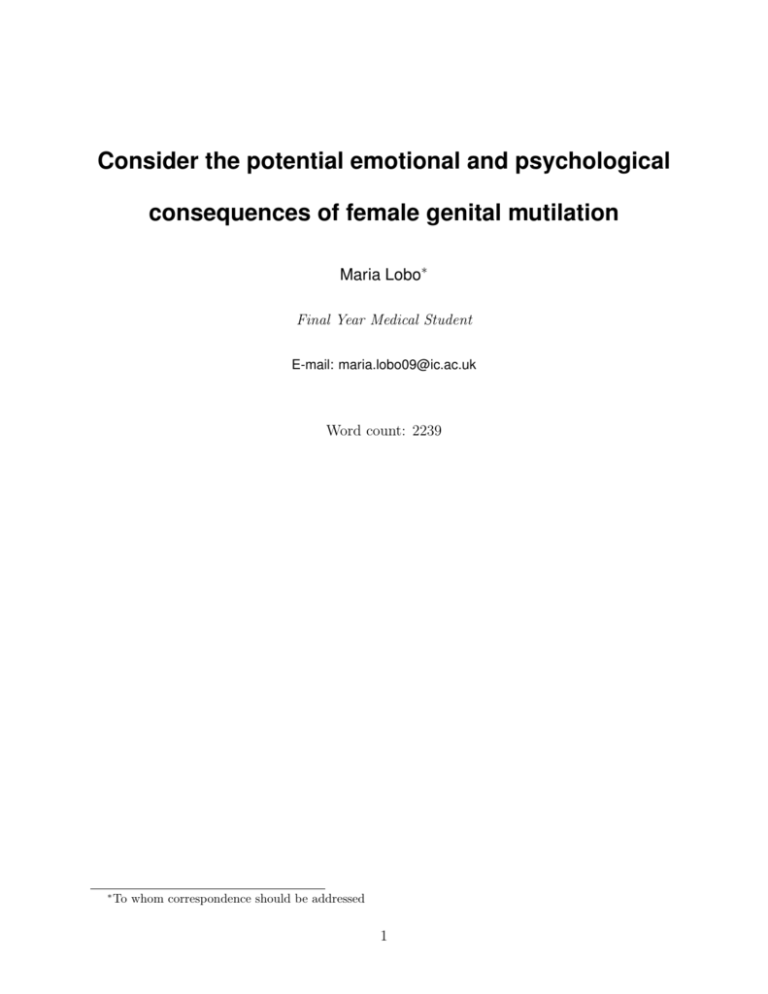
Consider the potential emotional and psychological
consequences of female genital mutilation
Maria Lobo⇤
Final Year Medical Student
E-mail: maria.lobo09@ic.ac.uk
Word count: 2239
⇤
To whom correspondence should be addressed
1
Introduction
Female genital mutilation (FGM), also known as female circumcision, encompasses all nontherapeutic procedures which damage the external female genitalia. 1 FGM is a traditional
practice in Africa (Figure 1) as well as parts of Asia, the Middle East and South America. 2
The severity of FGM may range from removal of the clitoris (type 1), to removal of the labia
minora and majora (type II), to narrowing of the vaginal opening (type III). In England and
Wales, our multi-ethnic society means that there are nearly 66 000 women living with FGM. 3
The physical consequences of female circumcision are well known. 1 In order to provide holistic
care, healthcare professionals need to be aware of the possible emotional and psychological
effects as well. This essay considers the consequences of FGM on a woman’s mental wellbeing, using poetry, art and first-hand accounts to illustrate what she may go through.
Figure 1: Prevalence of FGM in Africa. Women aged 15-49, data from national surveys
1997-2006. 2
2
A Shocking Experience
‘And under the shade of a tree...
The cutter began her work...
the pain...is so vivid to this day,
decades after it was done.
God, it was awful!’
- excerpt from ‘The Cut’ 4
Many circumcised women find the experience traumatising. This is unsurprising given
the nature of FGM: it is carried out using razorblades, knives, glass, sharpened rocks, scissors, burning or fingernails. Anaesthesia or analgesia are usually deemed unnecessary. 5 In
interviews with 23 Senegalese circumcised women, all but one described the day of her circumcision as horrifying (Figure 2) and over 80% still had unwanted re-experiences. 6 It is
likely that many women develop Post Traumatic Stress Disorder (PTSD), 6 living with a
range of symptoms including nightmares, hypervigilance, insomnia, emotional detachment
and overpowering emotions. 7
Figure 2: ‘Art against FGM’ by Conny Niehoff. 8 Circumcision is depicted as a vivid
harrowing event.
3
Effect on Family Relationships
Women who have been circumcised may feel betrayed or abandoned by the relative who has
brought them: 9
‘Why inflict me with this pain?
This real pain of primitive cultures
In tears I am, at every stage of my life
Mom and Dad, am I not a daughter?
Dear Brother, am I not a sister?
Dear mankind, wherever you are
Am I not a human being?
Tears, Tears, Tears’
- excerpt from ‘FGM poem from Somalia’ 10
Female genital mutilation is considered child abuse which is associated with a range of
psychological sequelae including anxiety, depression, anger and irritability. 9 Children and
adolescents are developing their world view, and when they are abused it can lead them to
take on traumatic expectations that no one can keep them safe them any more, as in this
author’s case 11 (also Figure 3). Before the circumcision, girls are often treated specially
by their family, being given presents and special food. 12 As a result, children may find the
experience confusing and it may arouse mixed emotions.
Even in countries where FGM is common, many do disagree with the practice. This can
cause disputes within a family, as a Togolese woman reported: ‘[my father] threatened to
divorce my mother if she took me or my sisters for female circumcision’. 13 These arguments
may in turn distress children. Similarly, many parents may be torn in their own minds
between concern for their child and societal pressures, as this mother living in Germany
relates: ‘I don’t think that [FGM] is a good thing. But I would be forced to circumcise my
4
Figure 3: ’Lost soul’ from ‘Art against FGM’ by Eva Harrer. 8 The girl seems isolated
in her fear.
daughter back in Togo...to avoid the problems I would have if I went against the will of my
family...I would be shunned by the family and everybody I know’. 13 Deliberating over this
decision may be a cause of great stress for a family. In several instances, a family member
who is a supporter of FGM will take the girl to be circumcised secretly, before the parent
who opposes FGM can intervene. 12,13 This can cause the parent intense anger and feelings
of guilt that they were unable to protect their child. FGM therefore impacts not only on the
girl affected, but on her whole family as well.
Sexual Consequences
A logical physiological effect of removing significant parts of the female genitalia is loss of
sexual function. The clitoris is the most consistently erotic part of a woman and may be
considered essential for achieving sexual response. 14 Due to the complexity of the interacting
factors that result in sexual satisfaction, women with damaged genital tissue may be able to
5
compensate through enhancement of other erotic areas or emotions. 14 Nevertheless, evidence
supports the notion that FGM damages women’s appreciation of sex. Of the 1695 women
reviewed in a recent meta-analysis, those who had been circumcised were 1.5 times more
likely to find intercourse painful compared to those who were not. 15 Women with FGM
experienced significantly less sexual satisfaction and sexual desire than those who had not
been subjected to FGM.
Sex is an important part of a loving relationship, and indeed sexual satisfaction has been
shown to predict marital satisfaction. 16 Sexual difficulties are considered a significant cause
of stress in a person’s life. 17 When a woman cannot enjoy sex, it reduces her to being merely
the means of her husband’s gratification:
‘How have I been transformed into a vessel
Carrying the burden of a man’s sexual pleasure
Robbed of my rights to even wrestle
For the part of me I treasure’
- excerpt from ‘Petals of Pride’ 18
In this way, FGM may make women feel that they are not worthy of sexual contentment.
It sustains the cultural message that it is wrong for women to desire sex. 13 If women do find
themselves desiring sex, they are thus likely to feel guilty. The effect of FGM on sex is also
damaging for men as being unable to satisfy their partners can stir feelings of inadequacy. 9,13
Effect of the Cultural Significance
The traditional meaning of FGM sets out how women should behave. Circumcision is expected to make women submissive to men (Figure 4). As one man of Nigerian origin explains:
‘Circumcised women are good women. They obey and respect their husbands’. 9 Osinowo and
Taiwo have shown that circumcised women have significantly lower self-esteem. 19 Circumcised girls also learn that they should not show any sexual desire in the future. A Togolese
6
supporter of FGM emphasises that ‘it is good when they cut the woman so that she does
not masturbate and does not flirt around’. 13 In this way, FGM is both an act that represses
women, and a symbol of their continued repression.
Figure 4: ‘Art against FGM’ by Stella Dreis. 8 The perceived family dynamic in cultures
where FGM is practised.
A More Complicated Reality
Despite the devastating consequences, the World Health Organization estimates that 3 million girls in Africa are at risk of undergoing FGM every year, and that over 125 million
girls and women worldwide are living with the consequences. 1 Respected village elders or
traditional birth attendants, women themselves, perform the procedure. 20 The girls who feel
the pain of FGM grow into mothers who lead their daughters to the same fate. How can
this agonising tradition persist? Perhaps it is partly because, for many women, the distress
caused by FGM is not as enduring as expected.
The importance of FGM in the community is easily undervalued by those outside of it.
It is a tradition that has lasted thousands of years. 21 For many women it holds such cultural
7
significance that they themselves look forward to the procedure. 22 Indeed, finding meaning
in an ordeal assists psychological adjustment. 23 The ceremonial aspect of FGM creates a tie
between young girls and their community and they may feel achievement at reaching adulthood. 9 Although in extreme pain, girls feel ‘happy’ and ‘proud’ to be circumcised. 22 Girls
go through FGM with their peer group, which may be a protective influence on their mental
health. Social support is an important resource for coping with stress, 24 and experiencing a
traumatic event with others seems to reduce the risk of PTSD. 23
The stigma of being uncut can cause women in some communities more psychological
distress than if they had had the procedure. The circumcised genitalia is considered beautiful 25 and more hygienic. 26 It protects a woman’s virginity and chastity. 25 Thus in cultures
where FGM is customary, being uncircumcised may lead a woman to think that she is dirty,
has unsightly genitalia, and is considered promiscuous. Without circumcision, a woman may
not be eligible for marriage, which may be the only way to ensure an economically viable
future. 27 Lack of circumcision may bring shame on the whole family. 20 These outcomes may
cause an uncircumcised woman considerable worry. She may also experience severe exclusion. Reports show that in several societies uncircumcised women are lowest in the social
hierarchy and are forbidden to speak at gatherings. 20
It is these contrasting issues at work and the poor quantity and quality of evidence available that mean that research so far has failed to show concrete conclusions about the psychological and social consequences of FGM. A meta-analysis of 17 studies comparing outcomes
of circumcised and uncircumcised women did not show a statistically significant difference
in psychological outcomes. 15 The studies analysed that addressed social consequences were
of too poor methodological quality to allow any conclusions to be made.
Effects on Physical Health
Nonetheless, the physical consequences of female circumcision are more evident. Any surgical
procedure carries risk of complications, and so in FGM women are exposed to risks with
8
no benefit of the procedure to their health. The physical complications of FGM may be
immediate, late or obstetrical (Table 1).
Table 1: Physical complications of FGM. Adapted from Reyners. 28
Immediate
Pain
Bleeding
Shock
Fractured clavicle, humerus
or femur (due to force
applied in restraining girl)
Urinary retention
Infection
Trauma to surrounding
organs (urethra, bladder,
perineum, anus).
Late
Scarring and keloid
formation
Pain while sitting or
walking
Dermoid inclusion cysts
Obstetrical
Prolonged second stage of
labour
Tears
Neurinoma pain
Impaired neonatal outcome
Dystocia
Dysuria, recurrent urinary
infections
Haematocolpos
Infertility
The different physical complications are listed as a reminder that they will all result in
consequent psychological burden to some degree (Figure 5). Pain affects mood, incontinence
can result in social isolation, and women with vaginal fistulae often experience tremendous
stigma and are treated as outcasts. 29–31 A difficult birth may be traumatising for the mother,
and if the baby is harmed this may cause severe grief. 32,33
A systematic review of evidence published between 1997 and 2005 showed that there was a
statistically higher risk of abdominal pain, discharge, infection and complications of delivery
for women who had been circumcised. 34 While for several health conditions no statistically
significant associations were found, this was suggested to be partly due to the lack of evidence
on more extensive operations. 34 A study of 290 Somalian women, of whom 88% had had type
III circumcision, shows how high the frequency of complications can be when severe FGM is
carried out. 35 39% of these women experienced immediate physical consequences, and 37%
reported late complications. It is thus clear that in countries with a high prevalence of severe
FGM, the physical complications make up a substantial unnecessary part of the (physical
9
Figure 5: ‘Art against FGM’ by Emmeke van der Put 8 A woman will live with the
effects of FGM for the rest of her life.
and psychological) suffering of women.
Implications for Healthcare Staff
What does this mean for healthcare professionals who come into contact with circumcised
women? Alongside addressing the physical consequences of FGM, staff must look out for
signs of psychological distress and psychosexual complications. 25 Circumcised women who
grow up in Western countries may be particularly susceptible to psychological consequences
because of the conflicting cultures that they are caught between. 36 They may have accepted
FGM as a part of life, and finding that it is condemned by other societies and that they are
perceived as ‘mutilated’ may come as a shock. They may question their identity and loyalty
to their culture. Their situation may give rise to feelings such as ‘humiliation, powerlessness,
inhibition, sense of betrayal of the family and shame’. 25 Many young people of ethnic minority
backgrounds already struggle with deciding whether to identify with the culture of their
10
family or that of the country they live in. 23 Discovering that a controversial and emotive
issue affects them personally is likely to complicate their predicament further. Therefore,
it is vital that staff are sensitive with patients who have been through FGM. It is more
appropriate to use the word ‘circumcision’ rather than ‘mutilation’ when speaking with a
patient, to avoid causing upset and stigmatisation. 26
11
Conclusions
Female genital mutilation has wide-ranging psychological effects. On the one hand, women
may find the experience so harrowing that it continues to distress them decades later. Circumcised women may find it harder to enjoy sex. They may feel unimportant because their
culture is teaching them that they are subordinate to men. Decisions around FGM may put
strain on the whole family. On the other hand, many women may have a positive view of
FGM because it connects them to their community. Being circumcised may make a woman
consider herself beautiful and allow her to be married. These conflicting sentiments make
eradicating FGM more challenging. Nevertheless, the physical risks of female circumcision
are clear, and themselves cause psychological suffering. It is important for healthcare professionals to be perceptive to the emotional difficulties that circumcised women may face,
especially as ethnic minority groups split between two cultures are likely to be more vulnerable.
12
References
(1) W.H.O., Female genital mutilation. 2014; http://www.who.int/mediacentre/
factsheets/fs241/en/.
(2) W.H.O., Female genital mutilation and other harmful practices. http://www.who.
int/reproductivehealth/topics/fgm/prevalence/en/.
(3) FORWARD, FGM Research. http://www.forwarduk.org.uk/key-issues/
fgm/research.
(4) Abdi, M. S. The Cut. 2008; http://www.wunrn.com/news/2009/01_09/01_
26_09/012609_fgm.htm.
(5) Kelly, E.; Hillard, P. J. A. Current Opinion in Obstetrics and Gynecology 2005, 17,
490–494 .
(6) Behrendt, A.; Moritz, S. American Journal of Psychiatry 2005, 162, 1000–1002 .
(7) Sarah Stringer, S. D. M. L., Laurence Church, Ed. Psychiatry P.R.N.; Oxford University
Press, 2009.
(8) ARTagainstFGM,
ARTagainstFGM.
http://www.art-against-fgm.com/
start.htm.
(9) Almroth, L.; Almroth-Berggren, V.; Mahmoud Hassanein, O.; Salah Eldin Al-Said, S.;
Siddiq Alamin Hasan, S.; Lithell, U.-B.; Bergström, S. Social science medicine 2001,
53, 1455–1460 0277–9536.
(10) Mohamed,
A.-N.
H.
FGM
Poem
from
Somalia.
www.globalroomforwomen.com/global-heart-blog/entry/
fgm-poem-from-somalia.html.
13
http://
(11) N.C.T.S.N.,
Understanding
Child
Traumatic
Stress.
2014;
http://
www.nctsn.org/resources/audiences/parents-caregivers/
understanding-child-traumatic-stress.
(12) Gray, C. S. Evaluation and Program Planning 1998, 21, 429–436 .
(13) Behrendt, A. Female Genital Mutilation/Cutting among Immigrants in Hamburg:
Knowledge, Attitudes and Practice. Hamburg: Plan International 2011,
(14) Catania, L.; Abdulcadir, O.; Puppo, V.; Verde, J. B.; Abdulcadir, J.; Abdulcadir, D.
The journal of sexual medicine 2007, 4, 1666–1678 .
(15) Berg, R. C.; Denison, E.; Fretheim, A. Report from Kunnskapssenteret 2010,
(16) Litzinger, S.; Gordon, K. C. Journal of Sex Marital Therapy 2005, 31, 409–424 .
(17) Holmes, T. H.; Rahe, R. H. Journal of psychosomatic research 1967, 11, 213–218 .
(18) AfricanFeminism, Petals of Pride. 2013; http://africanfeminism.com/2013/
11/28/16-days-of-activism-against-gbv-petals-of-pride/.
(19) Osinowo, H.; Taiwo, A. IFE Psychologia: An International Journal 2003, 11, p. 123–
130 .
(20) Baron, E. M.; Denmark, F. L. Annals of the New York Academy of Sciences 2006,
1087, 339–355 .
(21) Whitehorn, J.; Ayonrinde, O.; Maingay, S. Sexual and Relationship Therapy 2002, 17,
161–170 .
(22) Chalmers, B.; Hashi, K. O. Birth 2000, 27, 227–234 1523–536X.
(23) Atkinson, R. L. Hilgard’s introduction to psychology; Harcourt Brace College Publishers
Philadelphia PA, 1996; Vol. 12.
14
(24) Robin Kowalski, D. W. Psychology, 6th ed.; John Wiley Sons, 2011.
(25) Abdulcadir, J.; Margairaz, C.; Boulvain, M.; Irion, O. Swiss Med Wkly 2011, 140,
w13137.
(26) Utz-Billing, I.; Kentenich, H. Journal of Psychosomatic Obstetrics Gynecology 2008,
29, 225–229 .
(27) Cook, R. J.; Dickens, B.; Fathalla, M. F. International Journal of Gynecology Obstetrics
2002, 79, 281–287 0020–7292.
(28) Reyners, M. Reviews in Gynaecological Practice 2004, 4, 242–251 .
(29) Deshpande, M. A.; Holden, R. R.; Gilron, I. Anesthesia Analgesia 2006, 102, 1473–
1479 .
(30) Fultz, N. H.; Herzog, A. Journal of the American Geriatrics Society 2001, 49, 892–899
.
(31) Kabir, M.; Iliyasu, Z.; Abubakar, I.; Umar, U. 2003,
(32) Creedy, D. K.; Shochet, I. M.; Horsfall, J. Birth 2000, 27, 104–111 .
(33) Badenhorst, W.; Hughes, P. Best Practice Research Clinical Obstetrics Gynaecology
2007, 21, 249–259 .
(34) Makhlouf Obermeyer, C. Culture, Health Sexuality 2005, 7, 443–461 .
(35) Dirie, M.; Lindmark, G. East African medical journal 1992, 69, 479–482 .
(36) Johnsdotter, S.; Essén, B. 2004,
(37) Muse,
D.
A.
Feminine
Pains.
http://www.sistersomalia.org/
a-poem-for-women-who%E2%80%99ve-suffered-female-genital-mutilation/.
15
(38) 28TooMany, Painful Truth Poem. 2013; http://28toomany.org/blog/2013/
oct/3/painful-truth-poem-blog-and-poem-fgm-national-poet/.
(39) Lightfoot-Klein, H. 2nd International Symposium on Circumcision, San Francisco,
USA; 1991; Vol. 30.
(40) Dirie, W. The Waris Dirie Story. 2014;
http://www.fgmnetwork.org/
articles/Waris.html.
(41) Elnashar, A.; Abdelhady, R. International Journal of Gynecology Obstetrics 2007, 97,
238–244 .
(42) Toubia, N. New England Journal of Medicine 1994, 331, 712–716 .
(43) El-Defrawi, M. H.; Lotfy, G.; Dandash, K. F.; Refaat, A. H.; Eyada, M. Journal of Sex
Marital Therapy 2001, 27, 465–473 0092–623X.
(44) Alsibiani, S. A.; Rouzi, A. A. Fertility and sterility 2010, 93, 722–724 .
(45) Applebaum, J.; Cohen, H.; Matar, M.; Rabia, Y. A.; Kaplan, Z. Primary care companion to the Journal of clinical psychiatry 2008, 10, 453.
(46) Dalal, K.; Lawoko, S.; Jansson, B. Journal of injury and violence research 2010, 2, 41.
16

